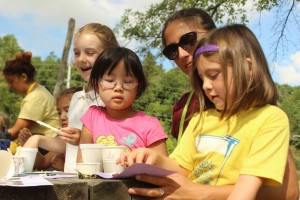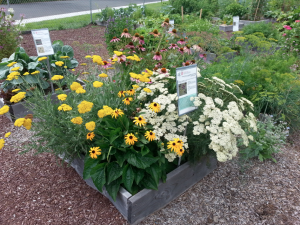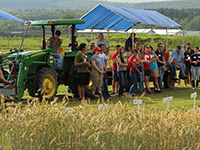What is Your Vision?
Criteria for a Good Garden Site
Creating a Welcoming Space
Designing For Children
A garden program has several phases. After you garner support, get people excited about the prospects, and gather a planning committee of ardent volunteers, it will be time to begin the planning and design portion of the project. This is the fun part; the possibilities are truly endless. During this process, the planning committee will be constantly looking to the future, and assessing your group’s commitment to the project, as well as the realistic expectations of implementation and maintenance.
Some garden projects are very small in size and scope. These can be compact, attractive, well-maintained gardens that serve a need. Although all the school curricula may not directly relate to the garden, a garden still can enrich a curriculum within a grade level, and can offer several concrete activities for the students.
Other gardens are large in size and overall scope. One school in upstate New York restructured the K-6 curriculum around the school’s garden program, and received major funding from a national corporation to overhaul its approach to computer technology, based on a garden-technology vision, which was conceptualized by the school’s “dream team.”
top
What is Your Vision?
Including the community is the best way to ensure a successful and long-lasting garden project. Hosting a garden design charette is a fun way to learn what others’ hope to get from the garden project and what their visions may be. Learn about Hosting a Garden Design Charette (pdf).
Whether your dreams are small or large, it pays to start off small the first year. Examine the overall vision of the gardening project, and choose one aspect that the planning committee can reasonably attain. It is much better to be wildly successful with a postage-stamp garden than to fail at a project so enormous in scope that it overwhelms everyone during the first go-round.
- What is the overall theme of the garden?
- If the gardening program flourishes, might there be opportunities for, and interest in, expansion?
- Try to paint a larger vision for the program, even if the garden itself will be diminutive.
- For example, a community group may plan a tiny garden outside the library, focused on a theme from a children’s book. How might this theme change next year? If it works well, can more themes be added? Can a portion of the garden that is geared more for adults be incorporated, as well? Even if the group is reticent about tackling too much, it is healthy to explore long-term possibilities.
Be sure to set up a meeting with the groundskeeper, custodian, and other individual who oversees the grounds. Gaining their trust, and opening lines of communication, should occur as soon as the committee can articulate what the garden might look like. Invite this person to comment on the design, and ask if mowing the areas adjacent to the garden will be affected by the plan. Is there a better location, or slight adjustment that needs to be made? Find out in advance.
top
Criteria for a Good Garden Site
Visit our downloadable checklist, Criteria for a Garden Site (pdf).
Learn about your soil type with this Soil Assessment Activity (pdf).
Criteria includes:
- Well-drained soil, free of heavy metals such as lead
- Full sun and protection from wind
- Proximity to a water source
- Nearness to classrooms or meeting place with seating and shade
- Storage space for tools and equipment
- Availability of additional space for composting, pathways, improvements, expansion
Other things to consider:
- Are there on-site materials that need to be removed, such as blacktop or debris?
- Should you perform a soil test before planning? If so, contact your local Cooperative Extension Office.
- Is the site location safe for participants? (Will motion-sensor lights be needed, and can they be installed?)
- Will you need a fence to prevent unwanted wildlife from entering?
- Is there a “garden guardian” who lives nearby who can watch over the site to help prevent theft or vandalism?
- Will you have a garden sign (or numerous signs) to educate visitors when no one is available to answer questions?
- How can you ensure the site is accessible to all?
- Are there public restrooms nearby?
- Is the site easy to get to? Accessible by public transportation? Is parking available? Does it have a bike rack?
- Have you communicated with the groundskeeper of the site?
Visit the Sustaining the Garden page for information about garden maintenance and summer care.
Creating a Welcoming Space
“I’ve been thinking a lot about equity and how to allow everyone to feel welcome in a garden-based learning program. I think that needs to be in the design process of any garden.” –Myra Manning, Maine School Garden Network Coordinator
Successfully engaging diverse community members is an important part of any garden project. Without diversity, the garden will lack representation from the whole community and thus will likely be less successful. Just as the garden is more interesting and beneficial with diverse plantings, a community project will have more sustained success with inclusion and input from diverse community members. Learn about Cultural Competency and Engaging Diverse Audiences (pdf) and visit the page about Effective Community Engagement.
Gardens should be designed so that they are accessible. “Accessible” has come to be synonymous with “accessible to wheelchairs,” but it may also mean a garden designed with sensitivity to visual impairment, varying degrees of manual dexterity, or varying levels of emotional/mental functionality. Accessibility may require having wide, uncluttered paths with beds that are easy for everyone to reach, or it may suggest that plants are accessible—again, having no “no” signs. It can also mean accessible to strollers. A garden that is too complicated, with plant species that are difficult to distinguish from one another, or cluttered with Latin names, may be inaccessible to children who are having a first experience with a garden. Often, accessibility boils down to “making everyone welcome.” Consider the abilities of volunteers as well as participants, particularly if the volunteers include older adults.
“Inclusivity is a critical practice in garden design and activity in that it ensures that all children irrespective of ability (cognitive or physical), age, gender, culture, language or economic status are provided equal access and are able to experience the garden as independently as possible, without stigma and with equal enjoyment and achieved success.” –Kaifa Anderson-Hall, former Program Director of the Washington Youth Garden at the US National Arboretum
Elements to consider for inclusivity:
- Incorporate multi-sensory plant materials.
- Use adaptive tools.
- Include shaded areas and places of respite- everyone appreciates an opportunity to sit on occasion.
- For signage, consider child-friendly images and multiple languages specific to the composition of users.
- Integrate culturally specific or diverse plantings for production gardens that match the cultural composition of the users.
- The entrance should be seamless to accommodate all abilities and sizes (no separate entrances).
- Integrate true raised garden beds – those elevated from the ground, accessible for seated, independent and supported standing individuals facilitates the engagement of different physical abilities.
- Consider including ADA compliant pathways or pathways wide enough for side-by-side movement and socialization for various degrees of aided (canes, walkers, wheelchairs) and non-aided (ambulatory) movement.
–Adapted from Kaifa Anderson-Hall, former Program Director of the Washington Youth Garden at the US National Arboretum

Expert Advice, A Word About Raised Beds
Raised beds are neat, clean, easy to maintain, and if they are of an appropriate width (not more than 3 feet) they can be easy for children to work in. However, a word of caution is necessary. Jane Taylor, founder of the Michigan 4-H Children’s Garden, warns that, “Most folks tend to slam-dunk rectangular raised beds in row by dull row.” She suggests a wheel-shaped arrangement, so that the center can become a location for a gazebo, or a few tables and benches for community sharing. This type of design is more friendly, and encourages the camaraderie desired for gardeners of all ages. She suggests that the ends of the beds be blunt, for safety reasons. Ms. Taylor also urges people to find ways to get kids inside the beds, by cutting small holes in the timbers and using stepping stones, chunks of concrete, old boards, or bricks for paths.
Cedar is an alternative for those with concerns about using pressure-treated lumber in raised beds. It is slightly more expensive but will be long-lasting. 
Designing For Children
Find out what national youth garden experts have to say about their Favorite Elements of Design (pdf).
A children’s garden should be designed for children. In the most practical way, it should suit their smaller stature.
- Raised beds should be no more than 3 feet wide
- Benches and other seating should be sized appropriately
- Garden maintenance should employ youth-sized tools.
- Themes that pique the interest of children, preferably suited to their penchant for fantasy, or adapted to familiar themes, such as a Peter Rabbit or an alphabet garden.
- Stepping stones that lead them into areas of the garden work well
- Incorporate clearly defined areas where they can get close to plants. Do no assume they will “stay out of the garden”—they will not, and you should not want them to.
- Avoid “no’s”; (no picking flowers, no walking on the mulch, no picking up stones, no playing in the water).
- Key words related to planning for kids: multi-sensory; gross motor activity; vivid color; safety; eating and tasting opportunities; interactive; interesting surfaces, such as sand and water; and attention grabbers.

Young children enjoy vibrant color, like to be immersed in flowers, and enjoy having suitable places to hide, such as beanpole teepees. There are endless numbers of fun elements to add:
- Brightly colored structures; scarecrows; interesting seating elements; painted stumps; sculptures made by the children; and brightly colored tiles.
- Height can be added with beanpole teepees, arches, pergolas, and even treehouses or gazebos.

Themes with child appeal:
- Pizza garden
- Teeny-tiny and giant garden
- A to Z flower garden
- Children’s literature themes (For example, Beatrix Potter garden)
- House of sunflowers
- Sundial garden
- Pond garden
- Butterfly garden
- Garden of primary colors
- Fairy Garden
- Three Sisters Garden
- Salsa Garden
- Art Garden
- Moon Garden (Include plants that bloom at night such as moonflower vine and flowering tobacco, Nicotiana)
- Visit Kidsgardening.org for even more youth-focused garden theme ideas
“I have found “thematic gardens” to be great sources of inspiration for designing educational gardens. For example, a rainbow-themed garden gives you an opportunity to integrate nutrition education by learning about the nutrient profiles of differently colored vegetables and fruits. A rainbow garden could also focus on flowers and weave in lessons on pollinators and beneficial insects that are each attracted to different flower colors and shapes. A second favorite thematic garden is a first aid garden to grow herbs and flowers that can be used as child-friendly medicine – calendula for making a healing salve, peppermint for brewing an iced tea, lavender for sewing a dream pouch… the list goes on!”— Carolina Lukac, Garden Education Manager for the Vermont Community Garden Network in Burlington, VT











